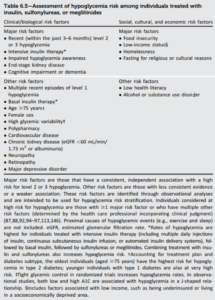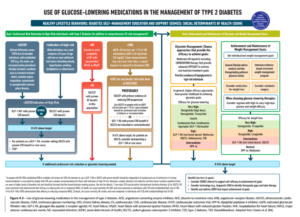The American Diabetes Association (ADA) Professional Practice Committee updates their guidelines for the management of type 1 and type 2 diabetes annually since 1989. Over the last several years new information, technology, and medications have been introduced into the standards of diabetic care guidelines. Below you will find some of the highlighted updates from the 2024 ADA guidelines that will be impactful in providing care to geriatric patients living with diabetes.
- Hypoglycemia Assessment, Prevention, and Treatment2
- New class A recommendation: Use of continuous glucose monitoring (CGM) is beneficial and recommended for individuals with type 1 or type 2 diabetes at high risk for hypoglycemia
- Table 6.5: “assessment of hypoglycemia risk among individuals treated with insulin, sulfonylureas, or meglitinides” updated based on recent evidence. Patients with 1+ major risk factors or 2+ other risk factors are considered high risk and should be prescribed Glucagon

- Diabetes Technology3
- New class A recommendations:
- New diabetes technology should be offered to all patients with diabetes
- Initiation of continuous glucose monitoring (CGM) devices should be offered to patients at diagnosis to promote early achievement of glycemic goals
- The below chart provides an update on substances and medications that may interfere with CGM devices
- New class A recommendations:

- Obesity and Weight Management for the Prevention of T2DM4
- New class A recommendation
- People with T2DM who are overweight or obese, the preferred pharmacotherapy should be a GLP1 agonist or dual glucose-dependent insulinotropic polypeptide and GLP1 agonist with greater weight loss efficacy (semaglutide or tirzapatide)
- New class A recommendation
- Pharmacologic Approaches to Glycemic Treatment5
- Updated recommendation: in adults with T2DM and established or high risk ASCVD, heart failure, and/or CKD, the treatment should include agents that reduce cardiovascular and kidney disease risk (SGLT2 inhibitors and/or GLP1 agonists), independent of A1c and in consideration of patient specific factors
- Summary of these recommendations:
- T2DM and HF (reduced or preserved ejection fraction):
- SGLT2 inhibitors: empagliflozin, dapagliflozin
- T2DM and CKD (eGFR 20-60 mL/min/1.73m2): SGLT2 inhibitors should be used, efficacy reduced when eGFR < 45 mL/min/1.73m2
- T2DM and CKD (eGFR < 30 mL/min/1.73m2): GLP1 agonist preferred
- T2DM and HF (reduced or preserved ejection fraction):
- Updates to pharmacotherapy in the perioperative setting6
- SGLT2 inhibitors should be held 3-4 days before surgery and other oral glucose lowering agents should be held the morning of surgery
- There is still little data on the safe use or influence of GLP1 agonists on glycemia and delayed gastric emptying in the perioperative setting. To reduce surgical risk, some hospitals use optimization programs to lower patients A1C prior to surgery, and others have A1C cutoffs on elective surgeries based on intensity and risk associated with the surgery.6

References
- American Diabetes Association Professional Practice Committee. Summary of Revisions: Standards of Care in Diabetes-2024. Diabetes Care. 2024 Jan 1;47(Supplement_1):S5-S10. doi: 10.2337/dc24-SREV. PMID: 38078579; PMCID: PMC10725800.
- American Diabetes Association Professional Practice Committee; 6. Glycemic Goals and Hypoglycemia: Standards of Care in Diabetes—2024. Diabetes Care 1 January 2024; 47 (Supplement_1): S111–S125. https://doi.org/10.2337/dc24-S006
- American Diabetes Association Professional Practice Committee; 7. Diabetes Technology: Standards of Care in Diabetes—2024. Diabetes Care 1 January 2024; 47 (Supplement_1): S126–S144. https://doi.org/10.2337/dc24-S007
- American Diabetes Association Professional Practice Committee; 8. Obesity and Weight Management for the Prevention and Treatment of Type 2 Diabetes: Standards of Care in Diabetes–2024. Diabetes Care 1 January 2024; 47 (Supplement_1): S145–S157. https://doi.org/10.2337/dc24-S008
- American Diabetes Association Professional Practice Committee; 9. Pharmacologic Approaches to Glycemic Treatment: Standards of Care in Diabetes—2024. Diabetes Care 1 January 2024; 47 (Supplement_1): S158–S178. https://doi.org/10.2337/dc24-S009
- American Diabetes Association Professional Practice Committee; 16. Diabetes Care in the Hospital: Standards of Care in Diabetes—2024. Diabetes Care 1 January 2024; 47 (Supplement_1): S295–S306. https://doi.org/10.2337/dc24-S016
